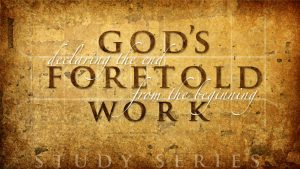Isaiah 63:18
“The people of thy holiness have possessed it but a little while: our adversaries have trodden down thy sanctuary.” (KJV)
“Your holy people possessed Your sanctuary for [only] a little while; Our adversaries have trampled it down.” (Amplified)
Just as Jeremiah’s prophecy was a catalyst for Daniel’s further quest for understanding (Dan 9:2), there can be no doubt that Ps 74 with Isa 63:18; 64:10-11 would have been an influence on his expectation concerning the fate of a future sanctuary that would be standing at the time of the end.
Whether Ps 74 was written before Isaiah or the reverse, it is Isaiah who adds something that entirely distinguishes the tribulation temple from any other.
.
The broad context surrounding the mention of the temple in Isa 63:18; 64:10-11 makes clear that Israel’s ultimate deliverance at the day of the Lord is envisioned as following in the wake of the devastating loss of the temple and the trampling down of the holy city. This is a theme that we see in many places throughout the prophets. But here’s what is so striking about Isaiah’s prophecy in particular. The temple that will be trampled burned and destroyed in the final tribulation has only been back in Jewish possession for “a little while” (Ps 74:7-8; Isa 63:18; 4:10-11; Dan 8:11, 13; 9:26).
No other temple in history answers to this description. It can only have reference to a third temple that has been only recently rebuilt, shortly before it is desecrated, trampled and burned by the self-exalting little horn (Dan 8:11; 9:27; 11:23, 31; 12:11).
Similarities in language suggest very strongly that either Isaiah is aware of a very early Asaph (Ps 74), or else a later Asaph is certainly aware of Isaiah‘s prophecy (Isa 63:18; 64:10-11) — and Daniel shows awareness of both. I tend to favor the view that the prophecy originated with the Asaph who served in the tabernacle of David.
Certainly, an early Asaph would have inherited all that Moses had said concerning the inevitability of exile and dispersion. Covenant chastisement would be the ever-looming threat until the expected day of national repentance that Moses foresees at the end of a final tribulation “in the latter days” (Deut 4:29-30; 29:4; 30:1-6).
It is just as likely that the original Asaph could have prophetically anticipated the destruction of the sanctuary. In any event, it seems clear that Ps 74:7-8; 78:59-60; 79:1, with Isaiah 63:18; 64:10-11 forms the prophetic background for an eschatology of tribulation that is centered around a very recently restored sanctuary.
Liberal commentators who hold that this portion of Isaiah could not have come from the pen of Isaiah of Jerusalem will, of course, assume that Ps 74 and Isa 63-64 are both written in retrospect after the exile, looking back and lamenting the bitterness and shock of the loss of the first temple.
We say, on the contrary! In both cases, the Spirit of prophecy is putting into the mouth of the suffering remnant of the final tribulation the cry for the long-awaited day of deliverance and permanent possession of the Land, according to the the Abrahamic and Davidic covenants.
(… More …)









